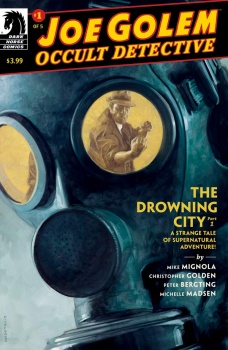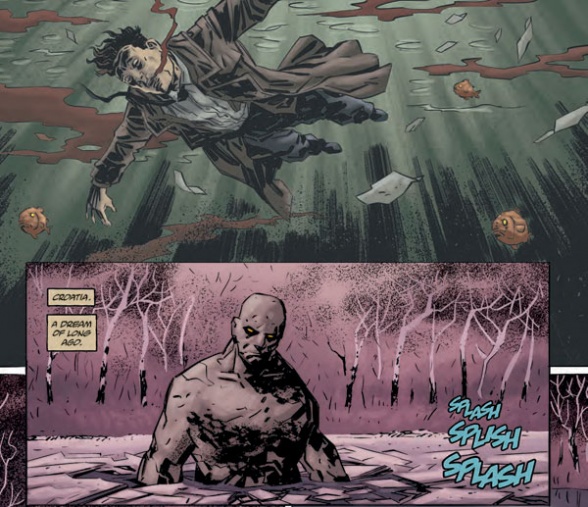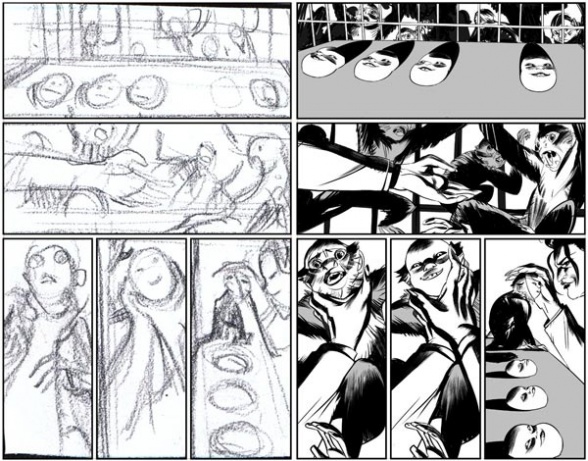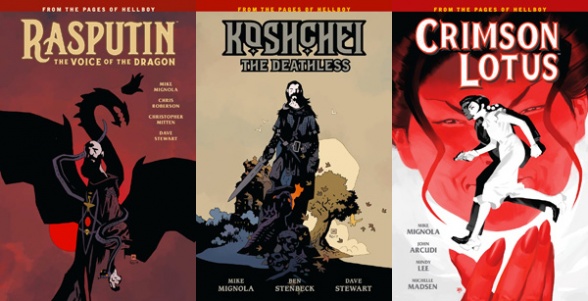
We’re almost at the end of another year, so now is the season of retrospective articles about comics of 2018. Normally we do a bunch of interviews with all the many creators on Mike Mignola’s books, but we’re doing something a little different this time. We spoke to Mike Mignola’s editor, Katii O’Brien about the year and the many books that have come out. And when we return in 2019, we’ll be talking about what’s ahead, so look for that in early January.
This has been a big year for Mike Mignola’s line of books. I think it’s fair to say 2018 was the year of the omnibus: two volumes of “Abe Sapien,” three of “B.P.R.D.: Hell on Earth,” and six of “Hellboy.” How on earth did you juggle all this?

Katii O’Brien: Very carefully, with as much advance planning as possible. It’s been a big year for us, a lot of stories are tying up and we’re getting to move to omnibuses on a few series at the same time. When I took on the Mignola books, I took over all titles with the exception of the “Hellboy” omnibuses, which the previous editor [Scott Allie] finished out. Each omnibus volume is a big project, and we want everything to end up in omnibus form eventually, so we want it to be perfect. There’s always juggling to do, but if we can plan ahead far enough ahead and figure out what we want early (cover artist, introduction writer, release date), then it’s pretty smooth sailing.
I kind of feel like that’s pretty much been your mission statement for the year. There’s been a lot of long-term planning paying off in these titles lately.

But before we get too deep into the Hellboy Universe stuff, let’s talk about Mike Mignola and Christopher Golden’s “Joe Golem: Occult Detective.” The current arc, ‘The Drowning City,’ is adapting the first half of the original prose novel Joe Golem and the Drowning City, but it’s more than just a straight adaptation. There’s a bit of reinvention going on too—the comics have extra backstory to incorporate, from Joe’s ex, Lori Noonan, to the rather surprising reveal that “Joe Golem” is set in the same universe as “Baltimore.” How do you approach material like this, where you’ve got readers that read the original novel first, but others that’ve only read the comics?
Katii: Adaptations are tricky because you want to make them accessible to readers who are new to the material, and still interesting to readers who have read the original format. And this series isn’t just prose to graphic literature, this is long form being adapted to a serialized format, so the pacing needs to be considered carefully too. Chris started the outline based on the original story in the novel, and as we worked through drafts we expanded parts and omitted parts to make sure we have movement and drama in each issue, and a lot of different visuals. I’ve read the novel of course, but when we began outlines I specifically avoided rereading it so that I could make sure I wasn’t supplementing it with memory. It needs to read clearly to fresh eyes.
This year Peter Bergting hopped on “Joe Golem” as the new interior artist with Michelle Madsen on colors. What do you feel Bergting and Madsen bring to the series?
Katii: Peter’s really hitting his stride with this series, we’ve all been so happy with his pages. He’s really nailing the supernatural atmospheres in particular, and he’s doing some cool angles that make for really dramatic shots in the scenes around the city.

In terms of the color, Michelle’s approach to light is really something special. You get the feeling that you’re watching these scenes at night through the fog, with just a gas lamp to see by. The light in these issues is very limited, especially shadowy, and that’s where Peter’s line art and Michelle’s color really work so harmoniously together.
It’s been interesting seeing Michelle’s work evolve this year. In a book like “Joe Golem,” she’s picking up where Dave Stewart left off, and using the same color language, but in “Witchfinder: The Gates of Heaven” with D’Israeli, the art style was something completely different. While it was a part of the “Witchfinder” series, ‘The Gates of Heaven’ art team actively reinterpreted the look of the title, even to the point that Clem Robins, who letters all the Hellboy Universe titles, chose to use a different style of lettering.
Continued belowKatii: ‘The Gates of Heaven’ was an unusual project for us. This story is one where old meets new, a lot of plot elements that are familiar to readers (Ogdru Hem, Panya, the Lipu Dagger) are introduced to Grey for the first time. D’Israeli’s style is really special, it has a whimsy to it that makes the steampunk elements feel even more fantastic. Stylistically, he sometimes omits outlines, usually in close ups or otherwise dramatic moments such as character reveals, and and he actually inks with tones instead of just black and white. He had some notes on color as most artists do, but we still gave Michelle lots of free rein, and she gave us a series that evolves in color as the issues go on. It’s almost psychedelic by the final issue when the drama and action reach the fever pitch.


As for the the lettering, it was Clem Robins’s own idea to use a different type family to match the offbeat art, so he did a type test with three different fonts and we settled on one. As a series “Witchfinder” is often more grounded, but readers know where Grey ends up, we know that the things he will encounter later are beyond what he comprehends at this point. We gave him a little taste of that.
This year “Hellboy and the B.P.R.D.: 1955” wrapped up with ‘Burning Season’ and you’ve just begun ‘1956.’ Personally, I’ve been excited about ‘1956’ since “Hellboy and the B.P.R.D.” was first announced. This story has a considerable overlap with “Hellboy in Mexico,” so there’s always been that challenge of how to address that aspect of the story without retelling it.
Katii: From the beginning we’ve been very conscious to not overlap with “Hellboy in Mexico” too much, but the great opportunity there is that we left a good part of his time in Mexico unexplored to begin with. As the series progresses, readers will see the specific way we avoid overlapping, which will pay off with something very special later on.
What really makes ‘1956’ stand out though is having three artists on one book, each tied to different plotlines. Without giving too much away (remember readers will have only reader #1 when this comes out), what drove this decision? And what do Mike Norton, Yishan Li, and Michael Avon Oeming bring to the book?

Left: Mike Norton
Center: Yishan Li
Right: Michael Avon Oeming
Katii: The idea to do three separate stories came from Chris [Roberson]. Initially this story was conceived as five distinct chapters with three different artists, but then Chris had the idea to interweave the stories so they could be told chronologically, basically with an episode of each story in every issue. In the approach to artists, we wanted to find three people who would do a great job of telling their own story, but also three styles that could work harmoniously in one issue. Further, this is a very human story arc, it’s not about huge monsters and paranormal entities the way previous stories have been. It’s human-driven, espionage-centric plot in all three parts, so we needed artists who can nail emotion and not just action. I don’t think it was until we saw the colors that we all realized just how well it works.
A title I’ve been very excited about lately is John Arcudi and Mindy Lee’s “Crimson Lotus.” Despite the character being in the Hellboy Universe for about a decade now, we know very little about Yumiko Daimio. In fact, “Crimson Lotus” as a whole is built in a world of unknowns—it’s an era we haven’t really explored yet, in a location we’ve never really been to in this universe, populated almost exclusively with characters we’ve never met before. This miniseries feels very free to go anywhere.
Katii: Yes, both John and Mindy have had a lot of creative freedom on the book. The best way to approach these miniseries is to not worry too much about tying it back up with the rest of the universe, just let it be its own story in that universe. John does a fantastic job with this one, as always, and he’s created a story that is a fun spy thriller with lots of supernatural twists and turns. Mindy was able to design our two protagonists from scratch, and create a lot of settings and creatures that we’ve never seen before. Some of her process work has been online, and we’ll have more of it in the sketchbook section of the trade.
Continued below

“Crimson Lotus” marks the first time the titular character of a Hellboy Universe book has been a woman, something I’ve wanted to see for a long time. And I’m happy to see a number of woman artists working on the Hellboy Universe books this year—it makes the books better when there’s diverse creators. As a fan, I just wanted to thank you for this, and I look forward to seeing more in future.
Katii: I’m very excited to have a book with a female title character. It will not the be the last. As for new artists, there will be some more new creators in the next year or so, as well as a fan favorite or two who are returning after a while.
This year we got a bunch of titles about the villains of the Hellboy Universe. “Rasputin: The Voice of the Dragon” wrapped up at the beginning of the year, we had “Koshchei the Deathless” in the middle of the year, and at its end we have “Crimson Lotus.” What’s behind this surge of villain-focus stories?

Center: “Koshchei the Deathless” cover by Mike Mignola and Dave Stewart
Right: “Crimson Lotus” cover by Tonci Zonjic (coming mid 2019)
Katii: We didn’t specifically plan to do a bunch of villain stories as far as I remember, but we’ve been interested in exploring some of the dark corners of the universe in the tradition of “Rise of the Black Flame,” “Sledgehammer 44,” and “The Visitor: How & Why He Stayed,” and I think villains are a natural place to start. We do want to leave stones unturned, we’re not looking to answer every lingering question and to pull at every thread, but we like to get a moment in time or a perspective from some of these bits and pieces of Mike’s world.
Given the way things are evolving in “B.P.R.D.: The Devil You Know,” the side titles seem to be expanding a lot on what’s unfolding now—Rasputin’s appearance in “Crimson Lotus” and his own series, ‘1956’ focusing in on Varvara, and “Koshchei” exploring the mythology of the Ogdru Jahad. They aren’t necessary to read “B.P.R.D.: The Devil You Know,” of course, but there is that sense of them drawing our attention to these different characters and plot points and reminding us why they’re important.
Katii: It’s been a very Varvara-centric year, for sure. It’s great for readers who concentrate on the core story, just “B.P.R.D.,” because if they want it there’s a lot more story out there about these characters and mythologies. But because we create stories and not encyclopedias, we don’t always give exhaustive back stories or complete origins, rather it’s another adventure featuring that character.

So, let’s talk about the elephant in the room. Next year, “B.P.R.D.” is coming to an end. This has been a long time coming, but Mike, you, and all the other creators on the book kept it quiet for a long time. In fact, there have been a lot of secrets you’ve been holding onto—Hellboy returning (though still dead), Rasputin returning, Varvara being Rasputin’s daughter—and you kept a lid on them so that readers could discover these moments on the page, not in a news article promoting the upcoming issue when Hellboy returns. I imagine you’ve still got a number of secrets you’re keeping for the final arc, but how’s it feel to finally have these moments out there and see readers reacting to them?
Katii: It’s exciting when big reveals finally get published, and it’s always wonderful when the fan response is so positive. Hellboy was always going to return at the end, he had to, but we certainly couldn’t say that. And the Rasputin-Varvara connection is something that’s been in the works for a long time too. You’re right, we don’t solicit a lot of these surprises, including both plot points and creators. When we solicited #6, for example, we deliberately did not list Mike as an interior artist. That was something that we wanted readers to be surprised by when they opened the book.
Continued belowSeeing Mike Mignola back on the book for those few pages was fantastic. There’s a bittersweetness to all this though. The ‘Ragna Rok’ arc has got Mignola back on the regular covers, but it’s also bringing so much to an end. It’s been really fascinating this year seeing the Hellboy Universe converge. “B.P.R.D.: The Devil You Know” is essentially a sequel not just to “B.P.R.D.: Hell on Earth,” but also “Abe Sapien: Dark and Terrible” and “Hellboy in Hell,” so I thought it was a nice choice to have Laurence Campbell, Sebastián Fiumara, and Mike Mignola on the book—an artist representing each series, if you will, with Christopher Mitten representing the spin-offs in his Varvara segment from #11.
Katii: “The Devil You Know” really is a complete finale to the current storyline across all the books. Laurence has the ability to handle the massive catastrophe as well as the emotional beats with such perfect nuance, and Seba so beautifully drew those first issues with Hellboy back. Pages 4-5 of issue #6 are a thing of beauty. We love Mitten, you’ll see his name on more books to come, and bringing him in as the guest artist for Varvara’s backstory worked so well because he’s great with historical stories. And you cannot beat having Mike back on interiors for even a few pages. It’s been wonderful to end the world with a team like this.

Left: Sebastián Fiumara (#6)
Center: Laurence Campbell (#10)
Right: Mike Mignola (#6)






